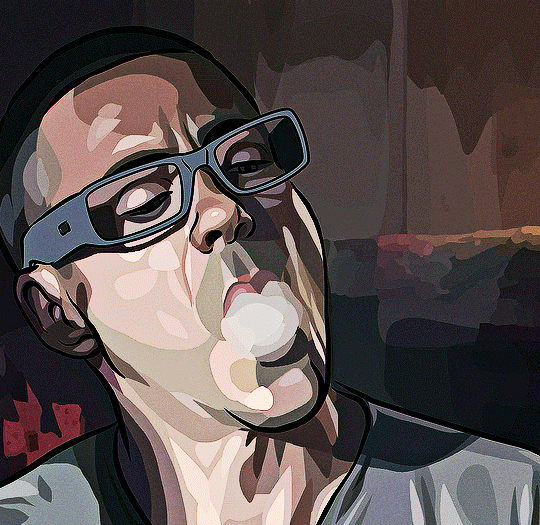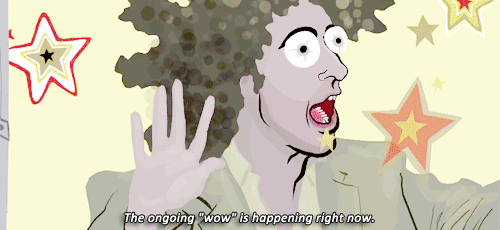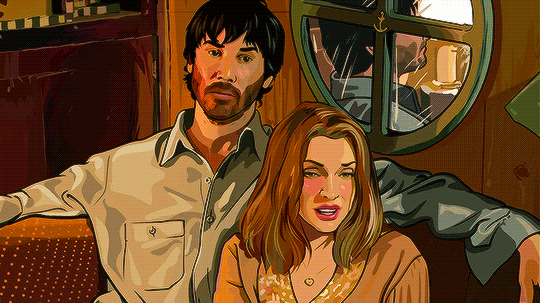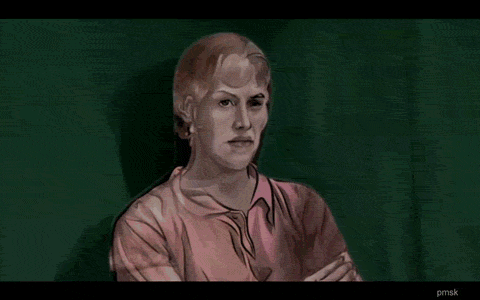originally posted at https://canmom.tumblr.com/post/693609...
Hi everyone! Apologies to friends back in Europe to be running so late today, I am afraid I’m on American time now.
And speaking of America… since I’m here I think I should probably show some American animation! Some American animation whose story is set right here in Orange County, California even.

Or more precisely, American rotoscopy!
So. Back on Animation Night 65, we shone a spotlight on the subject of rotoscopy!
Back then we saw how the rotoscope - the technique of drawing over live action film - was used extensively by Fleischer to animate the dances of jazz artists like Cab Calloway, then to a greater or lesser degree in many of the early films of Disney… and every so often revived for a new generation, e.g. by Ralph Bakshi in the 70s-80s, or a number of directors including Hiroshi Nagahama, Shunji Iwai and Dorota Kobiela and Hugh Welchman in the 2010s. [And closely related is of course motion capture (Animation Night 85), now a staple of CG animation.]
On that night I gave a brief mention to Richard Linklater, and the Rotoshop software of Bob Sabiston, but deferred that to another day. Well, that day is today!

The tricky part of rotoscopy is that it involves a lot of drawing. So does animation in general, but the rotoscopy pipeline is a little different - you don’t have a division of key animation and inbetweening, and it’s a lot harder to figure out how to use labour-saving techniques like loops and hold frames.
There are other difficulties, like working out which features on a photo to turn into lines, and keeping this decision consistent even when those features go into shadow or otherwise become hard to identify in the video footage. Cleaning up rotoscope animation is not fundamentally different from cleaning up traditional animation, and may even be harder because there are many more features in the drawing - small bumps on a contour line for example - that must be kept consistent.
For these reasons, rotoscoped movies often end up having to compromise a bit - reduced framerates and lowered drawing detail as in Aku no Hana (The Flowers of Evil), or giving up on rotoscopy entirely and just putting in solarised video footage as in Bakshi’s The Lord of the Rings. Sometimes these work (I will absolutely die on the hill that Aku no Hana is good actually), and sometimes they don’t (sorry Ralph.)

To try to make rotoscopy less time consuming while maintaining higher detail, former MIT researcher Bob Sabiston came up with a software called Rotoshop. The idea of Rotoshop is to help with interpolating vector animation: the artist can draw the extremes, and the program will match up the vector shapes in each frame and smoothly interpolate between them. If it doesn’t work right, the artist can tweak the parameters and try again.
This allows rotoscopy at high detail and a high framerate, with detailed visual elements like shadow and highlight shapes, plus the option to add a variety of digital textures and effects. The result is something that feels a little uncanny: you have the underlying 3D form of the actors coming through with startling clarity that would be nigh impossible in traditional animation, but all covered in oddly shifting vector shapes that don’t quite maintain their forms.
Sabiston got involved in animation during his time at MIT. Using early computer graphics, he created a number of short films such as God’s Little Monkey shown at the Siggraph Electronic Theatre in 1994, and Beat Dedication (1988) and Grinning Evil Death (1990), the latter two of which were shown on MTV’s Liquid Television block. I can only find GED, which you can watch here on youtube…
The film combines 3DCG and traditional animation credited to Sabiston, and you can see that he really knew what he was doing as an animator even at this point - handling a lot of tricky angles at honestly a very high framerate. I feel like some kind of digital interpolation must have been involved, unless Sabiston was just drawing like an absolute demon.
Sabiston released the first version of the Rotoshop software in 1997, and MTV was involved again as sponsors for the animation contest that motivated him. He used it to create a series of 30-second animations in New York called Project Incognito, followed by a short film called RoadHead in 1998 then Snack and Drink in and Figures of Speech in 1999. I believe I showed a few of those back on AN 65. Frustratingly, someone seems to have chopped Figures of Speech up into roughly nine second long clips which make it hard to determine if the full film has been uploaded anywhere, but here at least is Snack and Drink…
Compared to the films we’re about to look at, Snack and Drink features a constantly changing art style, interpreting the video in a different way every few seconds. It made a tour of film festivals, and presumably at some point caught the eye of director Richard Linklater, the other character in our story.
So, Linklater! This particular Richard grew up in Texas, and dropped out of school… not to animate but to work on an oil rig, where he got into novels, which developed in turn into a love of film when he returned to land and found a repertory cinema in Houston. So, he bought himself a Super-8 with his savings, founded the Austin Film Society with a number of academics and a SXSW founder, and started shooting short films in 1985, around the age of 25.
These early films were mostly short experimental films. In 1988, he finished his first feature film, It’s Impossible to Learn to Plow by Reading Books, a sizable undertaking; a Wikipedia editor writes…
a Super-8 feature that took a year to shoot and another year to edit. The film is significant in the sense that it establishes most of Linklater’s preoccupations. The film has his trademark style of minimal camera movements and lack of narrative, while it examines the theme of traveling with no particular direction in mind. These idiosyncrasies would be explored in greater detail in future projects.
His next two films, Slacker (a day in the life of ‘misfits and bohemians’ in Austin) and Dazed and Confused (a day in the life of a bunch of high schoolers on their last day), were similar: low-budget comedy-drama films drawing on his life, that saw cult success as Linklater toured film festivals. The next few, like SubUrbia (1996) and The Newton Boys (1998) - his ‘first Hollywood feature’ about a family of bank robbers - weren’t so successful, but it seems he was undeterred…

So, where does this come to animation? That turn comes in (engage echo) the new millenium, with Linklater turning to a 20 year old idea that he hadn’t quite figured out how to handle:
I think to make a realistic film about an unreality the film had to be a realistic unreality.
Sabiston’s software held the answer. Linklater and Sabiston (between them, I guess, my sources are contradictory) gathered thirty artists from around Austin, and assigned them different segments of the film so it would have a shifting style like his short films.
What’s it like, about? Waking Life is about a boy passing through an ethereal series of environments having philosophical and literary discussions with the various people he meets, gradually realising that he is in fact in a dream that he cannot wake from. As he starts to dream lucidly, he starts to despair at his inability to escape this solipsistic world…
Other scenes do not even include the protagonist’s presence but rather focus on a random isolated person, a group of people, or a couple engaging in such topics from a disembodied perspective. Along the way, the film also touches upon existentialism, situationist politics, posthumanity, the film theory of André Bazin, and lucid dreaming, and makes references to various celebrated intellectual and literary figures by name.

The visuals of course do a lot to help lend the film a suitably surreal mood - there is in a sense an underlying ‘reality’, showing through in the hard-to-draw perspectives and rotations, and yet it’s a view that’s constantly jittering and shifting and made of hard-edged shapes.
After this film found a large success, Linklater and Sabiston went their separate ways for a while. Sabiston continued to make short films with Rotoshop, including Yard, Earthlink Sucks, Grasshopper and a collection of shorts for Life360 on PBS, as well as a taking segment in the von Trier film Five Obstructions in which von Trier was challenged to shoot the same sequence with various gimmicks. Linklater meanwhile returned to live action, directing Tape (2001), School of Rock (2003), Before Sunset (2004) and Bad News Bears (2005). With a couple of mainstream comedies under his belt, he started to get more widely known.
So, A Scanner Darkly. This is based on the 1977 semi-autobiographical novel by famed science fiction author Philip K Dick, set in a near-future dystopian version of Orange County (where i’m staying!!! spooky) and following a group of heavy drug users. Per Dick’s account, it’s only lightly fictionalised, with its ‘Substance D’ taking the role of Dick’s use of amphetamines.

During this time, Dick lost a number of friends to the effects of heavy drug use in unsafe circumstances; his wife at the time Tessa Dick was heavily involved in supporting him. In fact, let me just quote the entire ‘background’ section from WP:
A Scanner Darkly was one of the few Dick novels to gestate over a long period of time. By February 1973, in an effort to prove that the effects of his amphetamine usage were merely psychosomatic, the newly clean-and-sober author had already prepared a full outline.[5] A first draft was in development by March.[6] This labor was soon supplanted by a new family and the completion of Flow My Tears, The Policeman Said (left unfinished in 1970), which was finally released in 1974 and received the prestigious John W. Campbell Award.[7] Additional preoccupations were the mystical experiences of early 1974 that would eventually serve as a basis for VALIS and the Exegesis journal; a screenplay for an unproduced film adaptation of 1969’s Ubik; occasional lectures; and the expedited completion of the deferred Roger Zelazny collaboration Deus Irae in 1975.
Because of its semi-autobiographical nature, some of A Scanner Darkly was torturous to write. Tessa Dick, Philip’s wife at the time, once stated that she often found her husband weeping as the sun rose after a night-long writing session. Tessa has given interviews stating that “when he was with me, he wrote A Scanner Darkly [in] under two weeks. But we spent three years rewriting it” and that she was “pretty involved in his writing process [for A Scanner Darkly]”.[8] Tessa stated in a later interview that she “participated in the writing of A Scanner Darkly” and said that she “consider[s] [her]self the silent co-author”. Philip wrote a contract giving Tessa half of all the rights to the novel, which stated that Tessa “participated to a great extent in writing the outline and novel A Scanner Darkly with me, and I owe her one half of all income derived from it”.[9]
There was also the challenge of transmuting the events into “science fiction”, as Dick felt that he could not sell a mainstream or literary novel after several previous failures.[citation needed][10] Providing invaluable aid in this field was Judy-Lynn del Rey, head of Ballantine Books’ SF division, which had optioned the book. Del Rey suggested the timeline change to 1994 and emphasized the more futuristic elements of the novel, such as the “scramble suit” employed by Fred (which, incidentally, emerged from one of the mystical experiences). Yet much of the dialogue spoken by the characters used hippie slang, dating the events of the novel to their “true” time-frame of 1970–72.

So a tough and very personal story to adapt, and at the time, Dick’s daughters Laura Leslie and Isa Hackett were hesitant to take further film adaptations after seeing what became of Minority Report and Paycheck. Linklater’s producer Tommy Pallotta wrote an entreaty to Dick’s agent Russ Galen, and after talking it over with Linklater, Dick’s daughters became convinced he wouldn’t treat it lightly and gave the go-ahead.
Despite Linklater keeping the budget small, the film involves a bunch of high-profile actors including Keanu Reeves, Robert Downey Jr., Winona Ryder and Woody Harrelson, all won around on the strength of the script. (Must have been a damn good script).
Still, we’re not here to talk about actors, we’re here to talk about aaaanimmattion! The film was shot in live action, with some unusual considerations. For a rotoscope film, it was not necessary to worry about things like mics appearing in shot, and the approach to lighting would be different - more important to give the rotoscopers enough information than to perfectly light its subjects for film. Rotoscopy also made it very straightforward to composite footage shot in Austin into backgrounds of locations in California.
Compared to Waking Life, this time Linklater wanted a much more detailed and consistent visual style… which was extremely tough for the animators, who had trouble getting to grips with the software and fell behind schedule. The answer to Linklater’s dissatisfaction was… unfortunately, crunch.
Animation and training for the 30 new artists had begun October 28, 2004. In late November, Mark Gill, head of Warner Independent Pictures, asked for a status report. There were no finished sequences, as the majority of animators were still learning to implement the film’s highly detailed style.[2] Under pressure, some animators worked 18-hour days for two weeks in order to produce a trailer, which seemed to appease Gill and Linklater.[2]
After this it got rather worse. The animation fell behind its punishing six-month(!) schedule, straining the budget; in answer to this, Pallotta changed the locks while Sabiston and his team were out at lunch, and replaced them with two new artists, crediting all the original team leaders (Patrick Thornton, Randy Cole, Katy O’Connor and Jennifer Drummond) as ‘additional animation’ despite the fact they basically did the entire pre-production.
Following thi quick disappearing-commissaring of the animation team, the parent studio extended the animation period and increased the budget; Pallotta installed himself in charge, and ran things a lot more strictly, ‘Disney style’, with shorter segments, deadlines, and a style manual. In the end the animation still took 15 months in total.

The result of all this effort is a film that really doesn’t look like many others, with complex blocky vector shadows that are constantly shifting over oddly perfect drawings which capture all the little bumps and contours in the human body in a way that would be nigh impossible for even the greatest animators from observation or imagination. The line style… I think also uses vector shapes to have a sense of tapering line weight, with the figures themselves outlined at the contour and significant folds, but interior shapes like hair often lineless.
And most significant is of course the incredibly detailed lighting - hard-edged like cel-shading but with many more layers and gradations of colour. The result is actually oddly flattening, since the shadow and highlight shapes are tracking underlying soft edges, so inevitably they become a little inconsistent. It’s a fascinating style and seems appropriate for a kinda surreal story where everyone’s taking a lot of drugs.
The film landed to ultimately mixed reviews; the people who liked it really liked it, while the detractors felt it went nowhere despite a lot of dialogue. Which means… after the struggles in production, it is probably going to be the last movie of its kind. I’d imagine any future rotoscope movies are more likely to use AI ‘style transfer’ filters to get the effect, rather than drawing over each frame this way.
So! Two fascinating and very distinctive films, both of which I’m very curious to experience at last. If you’d like to join me, they’ll be playing over at twitch.tv/canmom in about half an hour - please drop in chat and let me know when you’re here!
Comments